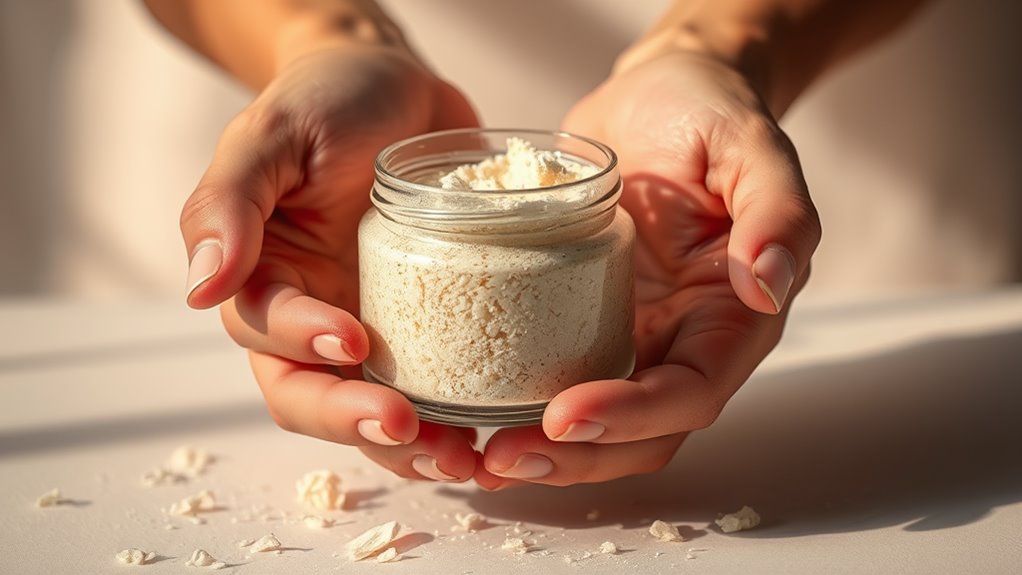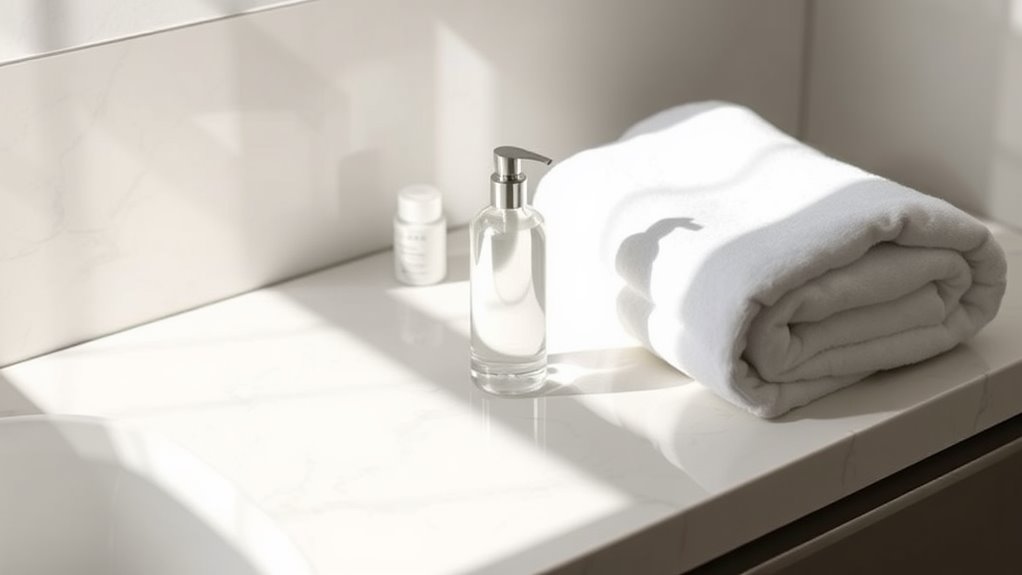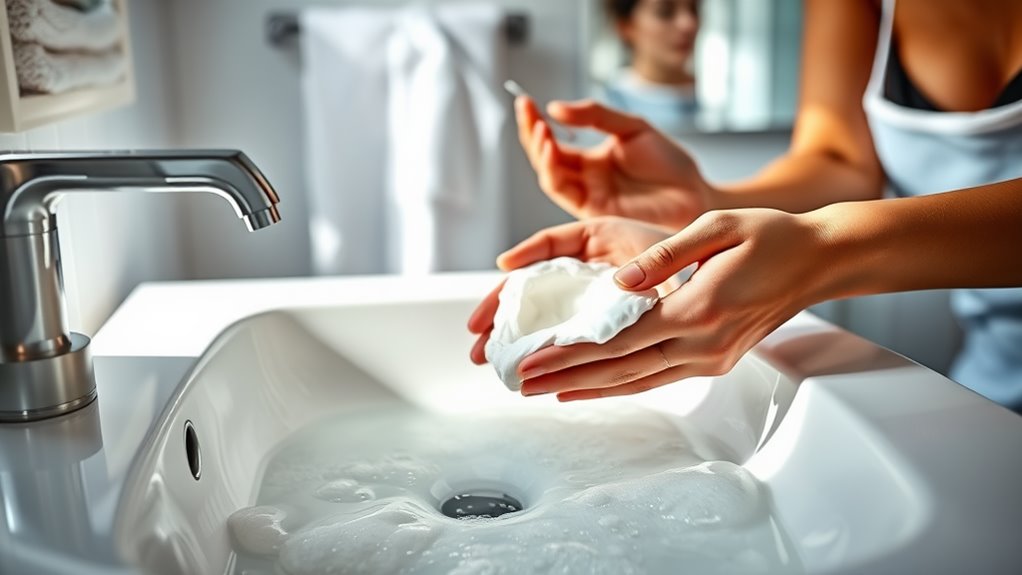Your Exfoliator Might Be Doing More Harm Than Good
Your exfoliator might be doing more harm than good by disrupting your skin barrier and causing irritation. Over-exfoliation can lead to redness, increased sensitivity, and dryness. If you notice stinging or flaky skin, it’s a sign your routine needs adjustment. Choosing the right exfoliator for your skin type is crucial to avoid adverse reactions. Discover how to ensure your exfoliation strategy promotes healthy skin without the risk of damage.
Key Takeaways
- Over-exfoliation can lead to redness, irritation, and increased sensitivity, compromising the skin barrier and causing more harm than good.
- Physical exfoliators may cause micro-tears in the skin, leading to irritation and long-term damage if used too aggressively.
- Chemical exfoliants can irritate sensitive skin types, emphasizing the importance of selecting the right exfoliant for your skin’s needs.
- Signs of over-exfoliation include dryness, flakiness, and a compromised moisture barrier, indicating a need to reassess your routine.
- Monitoring skin reactions is essential; adjust exfoliation frequency or switch to gentler alternatives to prevent adverse effects.
Understanding Exfoliation and Its Purpose
Exfoliation is a crucial skincare process that involves the removal of dead skin cells from the surface of your skin. This process promotes cell turnover, enhances product absorption, and maintains a fresh, vibrant complexion.
However, it’s vital to approach exfoliation with caution. Over-exfoliating or using harsh methods can lead to harsh exfoliation effects, including irritation, redness, and increased sensitivity. These adverse reactions can compromise your skin’s barrier, making it more susceptible to environmental damage and inflammation. Over-exfoliation can result in barrier damage, which further exacerbates these issues.
To achieve optimal results, you should aim for a balanced exfoliation routine tailored to your skin type. Understanding the science behind exfoliation empowers you to make informed decisions, ensuring that your skincare practices yield benefits rather than harm.
Prioritize gentle methods for lasting, healthy skin.
Types of Exfoliators: Physical vs. Chemical
When it comes to choosing the right exfoliator, understanding the two main categories—physical and chemical—is important.
Physical exfoliators involve manual scrubbing, using granules or tools to slough off dead skin. While they can provide immediate results, they may cause micro-tears and irritation if used too aggressively.
On the other hand, chemical exfoliators utilize acids or enzymes to dissolve dead skin cells at a molecular level. Common agents include alpha-hydroxy acids (AHAs) and beta-hydroxy acids (BHAs), which can offer deeper penetration and even skin tone. However, over-exfoliating with either type can lead to irritation and sensitivity, ultimately harming your skin’s health.
Each type has its benefits, but selecting the right one depends on your skin type, sensitivity, and goals. Mastering this choice is crucial to achieving the desired results without compromising skin health.
Signs You Might Be Over-Exfoliating
If you’re experiencing redness and irritation after exfoliating, it could indicate that you’re overdoing it. Increased sensitivity levels and dry, flaky skin are also signs that your skin’s barrier may be compromised. Over-exfoliating can lead to compromised skin health, so monitoring these symptoms can help you adjust your exfoliation routine for healthier skin.
Redness and Irritation
Over-exfoliating can lead to noticeable redness and irritation, signaling that your skin is reacting negatively to excessive treatment.
This inflammation occurs when the skin’s protective barrier is compromised, resulting in an increase in blood flow to the area. You’ll likely observe a flushed appearance, and the skin may feel warm or tender to the touch.
These symptoms suggest that the delicate balance of your skin’s microbiome is disrupted, potentially leading to further issues like breakouts or prolonged irritation.
If you notice persistent redness or discomfort, it’s crucial to reassess your exfoliation routine. Consider reducing frequency, switching to gentler products, or allowing time for recovery.
Prioritizing skin health will yield better, long-lasting results in your skincare regimen.
Increased Sensitivity Levels
As your skin undergoes regular exfoliation, you might notice an increase in sensitivity levels, which can be a clear sign of over-exfoliation. This heightened sensitivity can manifest as stinging, burning, or discomfort when applying products. It indicates that your skin barrier may be compromised, leading to increased vulnerability to environmental aggressors.
| Symptoms | Possible Causes | Suggested Actions |
|---|---|---|
| Stinging or Burning | Over-exfoliation | Reduce exfoliation frequency |
| Redness or Irritation | Skin Barrier Damage | Use soothing ingredients |
| Discomfort with Products | Sensitized Skin | Opt for gentle formulations |
Pay attention to these signs, and consider adjusting your exfoliation routine to restore skin balance.
Dry, Flaky Skin
When you notice dry, flaky skin, it could be a sign that your exfoliation routine has gone too far. Over-exfoliating strips your skin of its natural barrier, leading to moisture loss and compromised defense against environmental aggressors.
This disruption can trigger an inflammatory response, causing irritation and further desquamation. You may also encounter redness or a burning sensation, indicating your skin’s protective layer is compromised.
Ideally, exfoliation should enhance skin texture and promote cell turnover without causing distress. If you observe persistent dryness and flakiness, consider reducing the frequency of your exfoliation or switching to gentler methods.
The Impact of Harsh Exfoliation on Skin Barrier
Harsh exfoliation can significantly compromise your skin barrier, leading to a cascade of negative effects. When you strip away too much of your skin’s protective layer, you increase susceptibility to irritation, infection, and moisture loss. This can result in redness, inflammation, and an overall compromised complexion. Moreover, the essential benefits of exfoliation should be balanced with caution to avoid damaging your skin.
| Effect on Skin Barrier | Description |
|---|---|
| Increased Sensitivity | Skin becomes more prone to irritation. |
| Impaired Moisture Retention | Skin struggles to maintain hydration. |
| Higher Infection Risk | Barrier breakdown allows pathogens entry. |
| Accelerated Aging | Damage may lead to premature aging signs. |
To maintain a healthy skin barrier, opt for gentler alternatives that provide effective exfoliation without compromising skin integrity.
Common Ingredients to Avoid in Exfoliators
Maintaining a healthy skin barrier hinges not only on how you exfoliate but also on the ingredients you choose. Avoid exfoliators containing microbeads, as these plastic particles can cause micro-tears and environmental harm. Stay clear of sulfates; they strip natural oils, leading to dryness and irritation. Fragrances and artificial dyes may trigger allergic reactions, compromising your skin’s integrity. Strong acids like glycolic and salicylic can be beneficial in moderation but can also over-exfoliate if concentrations are too high. Lastly, steer clear of abrasive physical exfoliants, such as walnut shells, which can damage the skin’s surface. Remember, cleansing mistakes can also contribute to a compromised skin barrier, so be mindful of your overall cleansing routine.
How to Choose the Right Exfoliator for Your Skin Type
To choose the right exfoliator, first identify your skin type, whether it’s oily, dry, combination, or sensitive.
Then, consider any ingredient sensitivities you have, as certain components may irritate your skin.
Identify Your Skin Type
Understanding your skin type is crucial for selecting the right exfoliator, as different skin profiles respond uniquely to various formulations.
Start by assessing whether your skin is oily, dry, combination, or sensitive. Oily skin often benefits from chemical exfoliants like salicylic acid, which helps unclog pores.
If you have dry skin, opt for gentle, hydrating exfoliators, such as lactic acid, to avoid further dehydration.
For combination skin, a balanced approach using both physical and chemical exfoliants may yield optimal results.
Sensitive skin requires utmost care; seek out mild exfoliants with soothing ingredients.
Consider Ingredient Sensitivities
After pinpointing your skin type, it’s important to consider ingredient sensitivities when selecting an exfoliator.
Different skin types react uniquely to various ingredients; for instance, alpha-hydroxy acids (AHAs) can irritate sensitive skin, while beta-hydroxy acids (BHAs) might be more suitable for oily skin.
Always examine the ingredient list for potential allergens like fragrances, sulfates, or parabens, which can exacerbate issues.
If you have reactive skin, opt for gentle exfoliants with soothing components like chamomile or aloe vera.
You might also want to patch-test new products to observe any adverse reactions before applying them widely.
Ultimately, understanding your skin’s sensitivities is crucial for choosing an exfoliator that enhances your complexion without causing harm.
Recommended Exfoliation Frequency
Finding the right balance in exfoliation frequency is crucial for maintaining healthy skin. For most individuals, exfoliating 2 to 3 times per week offers optimal results, allowing for cellular turnover without overwhelming your skin.
If you have sensitive skin or conditions like rosacea, consider reducing your frequency to once a week to minimize irritation. Conversely, those with oily or acne-prone skin may benefit from more frequent exfoliation, potentially up to 4 times weekly, using gentle products.
Monitor your skin’s response; if you notice redness, excessive dryness, or peeling, reduce your exfoliation frequency immediately.
Ultimately, tailoring your routine to your skin’s unique needs ensures you achieve a healthy glow without compromising your skin barrier.
Gentle Alternatives to Traditional Exfoliation Methods
While traditional exfoliation methods can effectively remove dead skin cells, they may also cause irritation for some individuals, particularly those with sensitive skin.
Fortunately, there are gentle alternatives that can enhance skin renewal without the harsh effects. Consider incorporating the following options into your skincare routine:
-
Chemical Exfoliants: Use alpha-hydroxy acids (AHAs) or beta-hydroxy acids (BHAs) for a mild, effective exfoliation that penetrates without scrubbing.
-
Enzyme Exfoliants: Opt for natural enzyme-based products, like papaya or pineapple, which gently dissolve dead skin.
-
Gentle Scrubs: Select scrubs with fine, biodegradable particles to minimize abrasion.
-
Hydrating Masks: Apply masks containing soothing ingredients like hyaluronic acid or aloe vera to promote cell turnover while nourishing your skin.
Implementing these alternatives can help maintain your skin’s health and balance.




